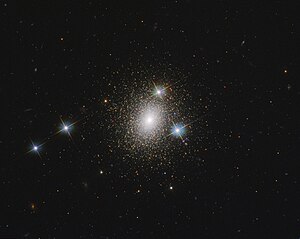Mayall II
| Kugelsternhaufen Mayall II | |
|---|---|
 | |
| Mayall II (von vier Sternen im Vordergrund umgeben), aufgenommen mithilfe des Hubble-Weltraumteleskops | |
| AladinLite | |
| Sternbild | Andromeda |
| Position Äquinoktium: J2000.0, Epoche: J2000.0 | |
| Rektaszension | 00h 32m 46,5s [1] |
| Deklination | +39° 34′ 39,7″ [1] |
| Erscheinungsbild | |
| Helligkeit (visuell) | +13,48 mag |
| Helligkeit (B-Band) | +14,58 mag |
| Winkelausdehnung | ca. 35" (D25, 25-mag-Isophote) |
| Farbexzess E(B-V) (Rötung) | 0,06 mag |
| Physikalische Daten | |
| Zugehörigkeit | Andromeda-Galaxie |
| Radialgeschwindigkeit | −331 ± 24 km/s |
| Entfernung | 2,5 · 106 Lj |
| Masse | 1 · 107 M☉ [2] |
| Kernradius | 0,21" ± 0,01" (2,5 ± 0,1 Lichtjahre) |
| Gezeitenradius | 21,8" ± 1,1" (263 ± 13 Lichtjahre) |
| Alter | ca. 12 Milliarden Jahre [2] |
| Metallizität [Fe/H] | −0,95 ± 0,09 |
| Geschichte | |
| Entdeckung | Nicholas Mayall, O.J. Eggen |
| Entdeckungsdatum | 1953 |
| Katalogbezeichnungen | |
| Mayall II / M II / MII, G1 / M31-G1 / NGC-224-G1, SKHB 1, HBK 0-1, GSC 2788:2139, M31GC J003247+393440 | |
Mayall II, auch bekannt als G1, ist ein Kugelsternhaufen in der Andromeda-Galaxie.
Er befindet sich in einer Entfernung von 130.000 Lichtjahren[3] vom Zentrum der Andromeda-Galaxie und ist rund 2,5 Millionen Lichtjahre von der Erde entfernt. Er ist der (absolut) hellste Kugelsternhaufen in der Lokalen Gruppe. Seine scheinbare Helligkeit beträgt +13,81 mag.[1] G1 hat die doppelte Masse von Omega Centauri.
Die große Metallizität und deren hohen Variabilität innerhalb des Haufens – was auf mehrere Sterngenerationen und eine langanhaltende Sternentstehungsphase hindeutet – begründen Zweifel, ob G1 wirklich ein Kugelsternhaufen ist, oder ob es sich nicht vielmehr um das Zentrum einer Zwerggalaxie handelt, deren Randgebiete durch die Andromeda-Galaxie konsumiert wurden. Im Zentrum des Kugelsternhaufens befindet sich ein 20.000 Sonnenmassen schweres Schwarzes Loch.[3]
Namensherkunft
Mayall II ist benannt nach Nicholas Mayall und Olin Jeuck Eggen, die den Sternhaufen 1953 entdeckten.
Die Bezeichnungen SKHB 1 geht auf Wallace L. W. Sargent, C.T. Kowal, F.D.A. Hartwick und Sidney van den Bergh zurück, die 1977 auch die Bezeichnung G1 (globular cluster) einführten.
Der Name HBK 0-1 geht auf J.P. Huchra, J.P. Brodie und S.M. Kent (1991) zurück.
Einzelnachweise
- ↑ a b SIMBAD Astronomical Database. In: Suchergebnis für "Mayall II". Abgerufen am 12. Mai 2011 (englisch).
- ↑ a b Ma, Jun; de Grijs, Richard; Fan, Zhou; Rey, Soo-Chang; Wu, Zhen-Yu; Zhou, Xu; Wu, Jiang-Hua; Jiang, Zhao-Ji; Chen, Jian-Sheng; Lee, Kyungsook; Sohn, Sangmo Tony: RESEARCH PAPER: Old stellar population synthesis: new age and mass estimates for Mayall II = G1. In: Research in Astronomy and Astrophysics. 9. Jahrgang, Nr. 6, Juni 2009, S. 641–652, doi:10.1088/1674-4527/9/6/003, bibcode:2009RAA.....9..641M.
- ↑ a b Ma, J.; de Grijs, R.; Chen, D.; van den Bergh, S.; Fan, Z.; Wu, Z.; Wu, H.; Zhou, X.; Wu, J.; Jiang, Z.; Chen, J.: Structural parameters of Mayall II = G1 in M31. In: Monthly Notices of the Royal Astronomical Society. 376. Jahrgang, Nr. 4, April 2007, S. 1621–1629, doi:10.1111/j.1365-2966.2007.11573.x, arxiv:astro-ph/0702012, bibcode:2007MNRAS.376.1621M.
Auf dieser Seite verwendete Medien
Autor/Urheber: Judy Schmidt from USA, Lizenz: CC BY 2.0
An intensely interesting globular cluster due to its unusual metallicity and possible home to an intermediate mass black hole, Mayall II or G1 is part of the Andromeda galaxy. It has been proposed and widely accepted that this cluster may very well be the remnant nucleus of a dwarf galaxy which had its outer layers pulled away and incorporated into the Andromeda galaxy. The cluster currently resides in Andromeda's outer reaches, which gives us a very good vantage point to see it without a lot of unrelated stars mingling in around it.
This is some of the finest data I've ever had the pleasure to work with, with many exposures combined to create a very smooth noise floor and incredible signal to noise ratio. Virtually everything you see is either a star or a background galaxy, with cosmic rays and instrumental artifacts almost completely removed. If you zoom in on the cluster, you can see even some very faint members of the cluster resolved. Exquisite.
Filters used include near-infrared and near-ultraviolet, resulting in very colorful stellar populations. Aside from the obvious brightest stars, many of the small, very red sources are actually foreground stars which may easily be mistaken as part of the cluster. I only know this because around 8 years elapsed between some of the exposures, revealing proper motions of several stars. I ended up compensating for this by nudging them into place for the composition. I also had to deal with some misaligned diffraction spikes, which involved carefully picking them up and rotating them to match with the others. You may still be able to see some misalignment if you look closely.
Data from the following two proposals were used to create this image: The Hot Stellar Content and HB morphology of the massive globular cluster G1 Resolving Multiple Stellar Populations in G1
North is 37.00° counter-clockwise from up.
Red: WFC3/UVIS F814W Orange: WFC3/UVIS F606W Cyan: WFC3/UVIS F438W
Blue: WFC3/UVIS F336W